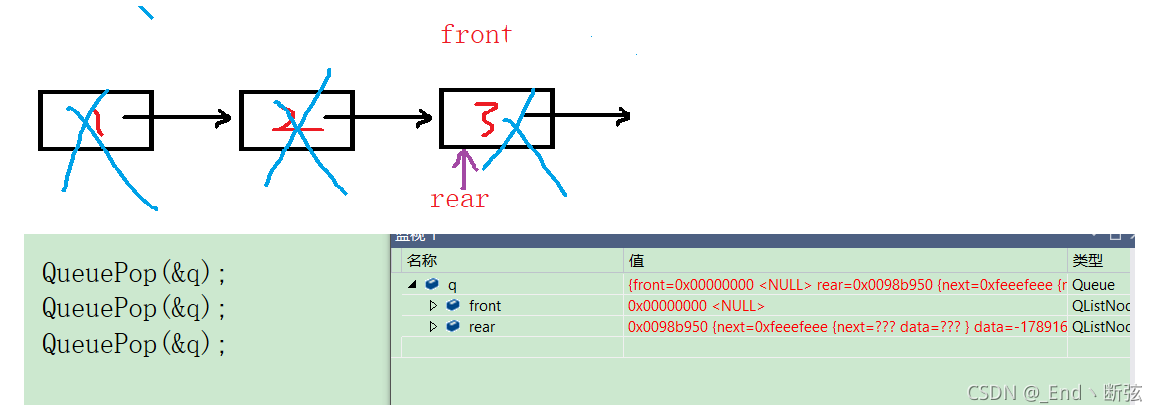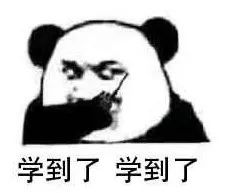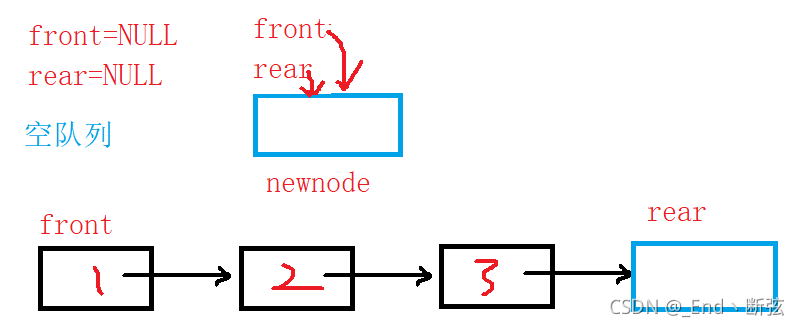队列的概念及结构
队列:只允许在一端进行插入数据操作,在另一端进行删除数据操作的特殊线性表,队列具有先进先出FIFO(First In First Out) 入队列:进行插入操作的一端称为队尾 出队列:进行删除操作的一端称为队头

队列的链式存储实现
采用单链表来实现队列的链式结构,设置一个头指针和尾指针。通常将队头指针和队尾指针封装在一个结构体中,并将该结构体类型重新命名为链队列类型。
typedef int QDataType;
typedef struct QListNode
{
struct QListNode *next;//数据域
QDataType data;//指针域
}QNode;
typedef struct Queue
{
QNode *phead;//头指针
QNode *ptail;//尾指针
}Queue;
队列初始化
初始化比较简单
// 初始化队列
void QueueInit(Queue* pq)
{
assert(pq);
pq->front = NULL;
pq->rear = NULL;
}
重点:入队列
入队列就是尾插,需要注意空队列。
// 队尾入队列
void QueuePush(Queue* pq, QDataType x)
{
assert(pq);
//开辟新结点
QNode *newnode = (QNode *)malloc(sizeof(QNode));
//判断是否开辟成功
if (newnode == NULL)
{
printf("malloc fail");
exit(-1);
}
newnode->data = x;
newnode->next = NULL;
//队列为空时
if (pq->front == NULL)
{
pq->front = newnode;
pq->rear = newnode;
}
else
{
pq->rear->next = newnode;
pq->rear = newnode;
}
}
打个断点调试

1,2,3就已经入队了。
重点:出队列
头删,保存下一个结点,free当前结点

错误的写法

从调试看出rear还在指向结点,虽然3已经free,但rear还在指向那里的空间。这个坑要单独处理。
void QueuePop(Queue* pq)
{
assert(pq);
//队列为空时就不能继续出了
assert(!QueueEmpty(pq));
if (pq->front->next == NULL)
{
free(pq->front);
pq->front = pq->rear = NULL;
}
else
{
Queue* next = pq->front->next;
free(pq->front);
pq->front = next;
}
}
获取队列头部元素
注意空队列
// 获取队列头部元素
QDataType QueueFront(Queue* pq)
{
assert(pq);
assert(!QueueEmpty(pq));
return pq->front->data;
}
获取队列队尾元素
跟上面的一样
QDataType QueueBack(Queue* pq)
{
assert(pq);
assert(!QueueEmpty(pq));
return pq->rear->data;
}
检测队列是否为空
// 检测队列是否为空,如果为空返回非零结果,如果非空返回0
int QueueEmpty(Queue* pq)
{
assert(pq);
return pq->front == NULL && pq->rear == NULL;
}
队列的销毁
// 销毁队列
void QueueDestroy(Queue* pq)
{
assert(pq);
QNode *cur = pq->front;
while (cur)
{
Queue *next = cur->next;
free(cur);
cur = next;
}
pq->front = pq->rear = NULL;
}


